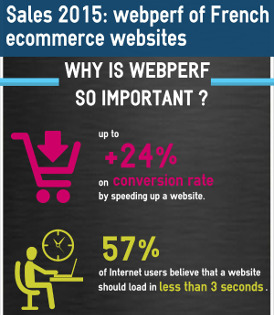57% of Internet users consider that a website should be loaded in less than 3 seconds. In addition, according to the FEVAD: “61% of e-buyers (had) the intention to make their purchases on Internet during the winter sales” 2015.
Based on this observation, we took interest in the main French e-commerce sites’ performance, before and during this crucial period.
This study was carried out in partnership with Fasterize. Below is a compilation of the results represented in graphics. You will find some extra details and additional information later in this article.
Review before the sales: performance not at their very best
When we have a look at the performance of the main French e-commerce sites, one observation must be underscored: the web performance issue is still far from being at the center of all attentions. The interaction with the page is made possible on an average basis of 2 seconds, the total loading time goes beyond 8.5 seconds, and this at an average weight of 1.6 Mo.
Loads of improvements, sometimes very simples, are yet possible. Among the most frequent ones, we could quote the possibility of optimizing the volume of data that flows through the network (via minification and resources’ compression mechanisms). For instance, fnac.com can reduce its total weight by 28%, right by activating the Gzip compression of its textual resources. In addition, considering that it is the second most visited e-commerce site in France, with almost 8,5 millions of single visitors per month, we could imagine that the bandwidth would save 3.5 terabytes per month.
But the main improvement target is the pictures. Pictures account for 62% of pages’ total weight and for 65% of requests. Therefore, a special attention should be paid to them. These big well-known e-merchants don’t use enough very common practices like establishing CSS sprites, optimizing weight for a digital display without quality loss (suppression of EXIF data, description, creation date…), or again the settling up of a lazy-loading mechanism.
Review after the sales
The impact of the 2015 winter sales on the main French e-commerce sites has been various. In a first part, it is to be welcome that at first sight, no “sales time” website version created bad performance issues.
Leroy Merlin proves to be the best performer, the only one managing to get an average under 1.5 seconds, in spite of a slight increase (+4.2%) in sales time. Fnac (a French chain of stores that sells cultural products) remains at the back of the line.
Several causes explain this big gap.
Firstly, we notice an issue at the level of the initial response of the Fnac’s web server, with an average time of 1.4 seconds in opposite with Leroy Merlin who gets it at 400ms.
Let us remind you the recommendation given by Google about it: the waiting time before reception of the first byte must not exceed 200ms !
On the other hand, we also notice that the Fnac’s site consumes much more JavaScript than Leroy Merlin does. Indeed, 380 Kb of JS are synchronously loaded (delaying then the page interactivity) whereas it is 130 Kb for Leroy Merlin.
The list of possible improvements to speed up the loading of the Fnac’s site is still long. If curious, do not hesitate to read this complete report we generated from our online service:
https://www.dareboost.com/en/report/54d388f3e4b0612820e4feef
As Steve Souders, an expert of web performance (who used to work with Yahoo and Google about it), says:
80-90% of the end-user response time is spent on the frontend. Start there.
Following the best practices related to web pages performance is nowadays necessary in order to ensure fast pages and therefore to make sure to get good business results with satisfied users!
Does your website follow the performance best practices? Could you enhance your loading time?
Free performance test with Dareboost.com

